The Calcium Phosphate Market is estimated to be valued at USD 1,008.1 million in 2025 and is projected to reach USD 1,657.7 million by 2035, registering a compound annual growth rate (CAGR) of 5.1% over the forecast period.
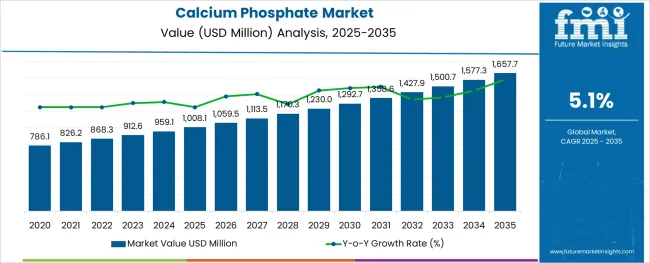
The calcium phosphate market is demonstrating steady growth as demand for functional food ingredients, nutraceuticals, and specialty fertilizers continues to rise. This growth is being shaped by increasing awareness of dietary calcium’s role in bone health, coupled with its functional properties in food processing and agriculture.
Manufacturers are focusing on improving purity, solubility, and bioavailability, which has enhanced its applicability across diverse industries. Regulatory support for food-grade additives and innovations in sustainable production methods are further strengthening the market outlook.
Future opportunities are expected to emerge from the expanding fortified foods segment, as well as the development of eco-efficient fertilizers and biocompatible materials for medical applications. These drivers are paving the path toward wider adoption and technological advancement in the calcium phosphate industry.
The market is segmented by Form, Application, Product Type, End-user, and Distribution Channel and region. By Form, the market is divided into Crystalline and Amorphous. In terms of Application, the market is classified into Acidity Regulator, Leavening Agent, Flour Treatment Agent, Antioxidant, and Forming Agent. Based on Product Type, the market is segmented into Di-Calcium Phosphate, Mono Calcium Phosphate, and Tri-Calcium Phosphate. By End-user, the market is divided into Food & Beverages, Pharmaceutical, and Chemical.
By Distribution Channel, the market is segmented into Hypermarket/Supermarket, Convenience Store, Online, and Direct Selling. Regionally, the market is classified into North America, Latin America, Western Europe, Eastern Europe, Balkan & Baltic Countries, Russia & Belarus, Central Asia, East Asia, South Asia & Pacific, and the Middle East & Africa.
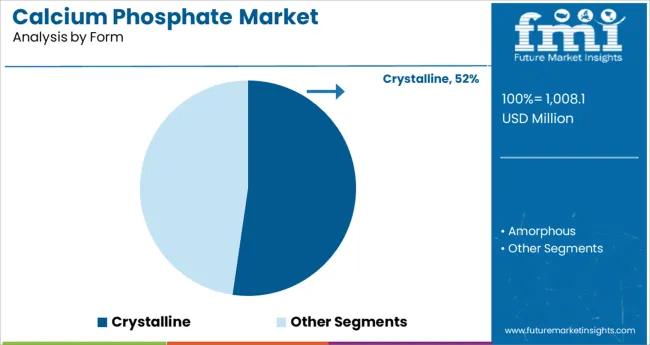
When segmented by form, crystalline calcium phosphate is anticipated to account for 52.3% of the total market revenue in 2025, making it the leading form segment. This leadership is being attributed to its superior stability, high purity levels, and consistent performance in food and pharmaceutical formulations.
The crystalline structure has allowed manufacturers to produce materials with predictable solubility and controlled release characteristics, which has reinforced its adoption in nutritional supplements and controlled-fertilizer applications.
lts ease of handling and compatibility with other ingredients have also contributed to its preference over amorphous alternatives. The ability to meet stringent quality standards and regulatory requirements while delivering reliable functional performance has solidified the crystalline segment’s dominance in the market.
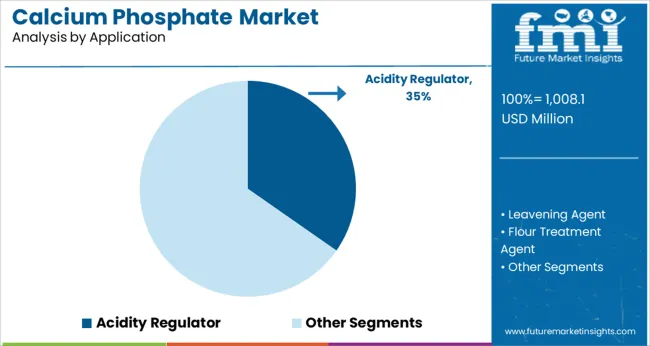
In terms of application, acidity regulator is projected to contribute 34.7% of the market revenue share in 2025, establishing itself as the top application segment. This prominence is being driven by the growing use of calcium phosphate as a buffering agent and stabilizer in processed foods, beverages, and dietary supplements.
Its capacity to maintain pH balance and improve texture without compromising nutritional value has made it indispensable in food manufacturing. Widespread adoption is also being supported by its multifunctionality, offering both acidity control and calcium fortification.
Increased consumer demand for clean-label and fortified food products has further reinforced its usage as a preferred acidity regulator. This versatility and alignment with health-oriented consumption trends have cemented its position as a leading application within the market.
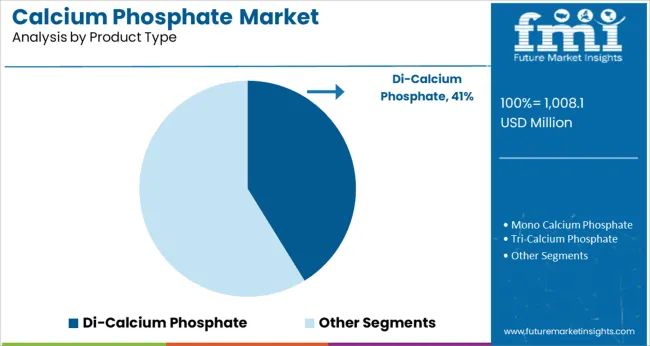
When segmented by product type, di calcium phosphate is forecast to represent 41.2% of the market revenue in 2025, securing its position as the foremost product type. This dominance is being supported by its favorable balance of calcium and phosphorus content, which has enhanced its utility in animal feed, food fortification, and pharmaceutical preparations.
Its excellent bioavailability, coupled with cost-effective production, has made it a preferred choice across diverse end uses. The widespread acceptance of di calcium phosphate in livestock nutrition, due to its role in improving skeletal health and productivity, has further bolstered its share.
Its adaptability to meet both human and animal nutritional needs while complying with regulatory standards has ensured its sustained leadership in the market.
One of the main minerals, calcium phosphate, is present in nature in a variety of forms. Calcium and phosphorous are combined to form calcium phosphates. In the form of carbonated hydroxyapatite, calcium phosphates, an essential component of biological hard tissue, are present in significant amounts in bones, tendons, and teeth. It gives these organs hardness and stiffness.
Calcium phosphates in their crystalline form are widely used in biomedical applications that aid in the reorganization of bone minerals. The other varieties of calcium phosphate are widely used in numerous industries. As a leavening agent, calcium phosphates are widely used in salts, sauces, and baked goods.
Calcium phosphates, which are frequently found in calcium supplements, also help to increase calcium content. In addition to the food industry, it is a crucial component in the production of a variety of phosphate fertilizers. A common stabilizer in plastics and plant food, this same acid calcium of calcium is created by processing mineral salts with sulfuric acid.
A new report published by Future market insights, titled, Calcium Phosphate Market -Global Opportunity Analysis and Industry Forecast, 2025 to 2035,projects the global Calcium Phosphate Market to reach USD 1,500.8 million by 2035 and is expected to grow at a CAGR of 5.10% from 2025 to 2035.
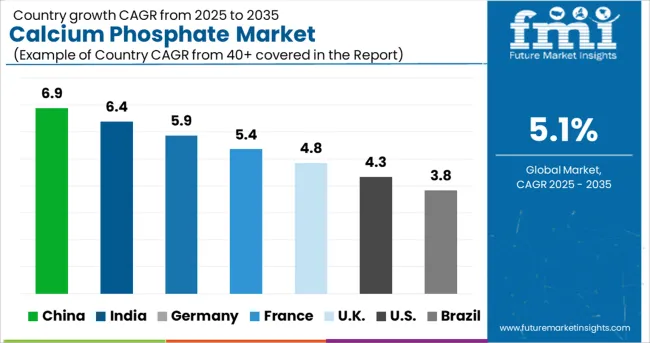
The largest portion of the worldwide calcium phosphate market is held by North America. Because of the growing elderly population, more people are taking supplements for their bones and joints, which is helping the calcium phosphate market expand.
Europe's calcium phosphate market is anticipated to grow at a rapid rate. The market for calcium phosphate in the Asia Pacific region is taking advantage of the growing consumer preference for processed foods which results in an increase in the market for calcium phosphates in the Asia Pacific region.
Due to its widespread use in implant reconstructive surgery and nutritional supplements, the global Calcium phosphate market is predicted to experience significant growth in Japan as a result of the country's growing elderly population.
The calcium phosphate market is projected to grow at a CAGR of 5.10% from 2025 to 2035. The growth in the calcium phosphate market is mainly attributed to the increasing adoption of this product in various industries such as food and beverage, construction, and others. North America has been witnessing significant growth owing to the increase in demand for this product from both domestic and international markets.
Factors that are supporting the growth of the calcium phosphate market include rising population, increased industrialization, and growing awareness about the benefits of this mineral. However, some challenges that are anticipated to hamper the growth of this market include concerns over the availability and pricing of this product.
The market for calcium phosphates is being driven by medical staff's trend for biocompatible material for re-structuring purposes. In dental and orthopedic applications, calcium phosphate is frequently used as a synthetic graft substitute during implant surgery.
It is widely used in nutritional supplements because it has good biocompatibility, aids in calcium replenishment, especially in older populations, and prevents osteoporosis. It also aids in tissue regeneration.
As a result, the market for calcium phosphates is expanding due to the rising number of elderly people and the relatively inexpensive treatment options for implant reconstructive surgery using calcium phosphates.
Additionally, calcium phosphate is widely used as a food additive in the food industry. It thickens and stabilizes things, so water and oil-based ingredients frequently use it. Other distinctive qualities of calcium phosphate include regulating acidity, aiding in the retention of moisture, and treating flour. As a result, it is widely used in the manufacture of baked goods and processed foods because it preserves the texture of frozen vegetables.
People with chronic kidney diseases may experience negative side effects from consuming large amounts of calcium phosphate. As a result, people with kidney disease should avoid using products that contain calcium phosphate.
When compared to other biomaterials available for use in dental and orthopedic applications, calcium phosphate, however, exhibits poor mechanical properties. As a result, extensive research is needed to improve calcium phosphate's biomedical properties. As some other biomaterials are easily available on the market, this has an impact on the growth opportunities of the calcium phosphate market.
The Calcium Phosphate Market in market is expected to grow at a CAGR of 5.10% during the forecast period of 2025 to 2035. The calcium phosphate market is expected to grow owing to the increasing demand from industrial and supermarket distributors. The growing incidence of bone health issues among the population is fueling the growth of this market.
Supermarkets and industrial distributors are driving the growth of the calcium phosphate market. The increasing incidence of bone health issues among the population is fueling the demand for this product. The growth can be attributed to the rising demand from supermarket and industrial distributors due to its affordability and easy availability.
Furthermore, the growing trend of green infrastructure is also benefiting the market as it requires higher levels of calcium phosphate in various construction projects.

The competitive landscape of the calcium phosphate market is expected to witness significant growth in the near future. The increasing demand for calcium phosphate from various end-use industries is expected to drive the growth of the market.
Some of the key players in the calcium phosphate market are BASF SE, Mitsubishi Chemical Corporation, and SABIC Innovative Plastics Company. These companies are engaged in manufacturing and supplying a wide range of calcium phosphates products.
They are also focusing on developing new products and expanding their product portfolio. This is expected to help them maintain their leadership positions in the market.
| Attribute | Details |
|---|---|
| Forecast Period | 2025 to 2035 |
| Historical Data Available for | 2020 to 2025 |
| Market Analysis | USD million for Value and Units for Volume |
| Key Regions Covered | North America, Latin America, Europe, Asia Pacific, Oceania, Middle East and Africa (MEA) |
| Key Countries Covered | The USA, Canada, Mexico, Germany, The United Kingdom, France, Italy, Spain, China, Japan, India, South Korea, Australia, Brazil, Argentina, South Africa, UAE |
| Key Segments Covered | By Product, By Form, By End-user, By Application, By Distribution Channel, By Region |
| Key Companies Profiled | Advance Inorganics, Nitta Gelatin Inc., Raymon Patel Gelatine Pvt. Ltd., Sigma-Aldrich Co. LLC., Timab, Fosfitalia SpA, Gadot Biochemical Industries LTD. |
| Report Coverage | Market Forecast, Company Share Analysis, Competitive Landscape, DROT Analysis, Market Dynamics and Challenges, and Strategic Growth Initiatives |
| Customization &, Pricing | Available upon Request |
The global calcium phosphate market is estimated to be valued at USD 1,008.1 million in 2025.
It is projected to reach USD 1,657.7 million by 2035.
The market is expected to grow at a 5.1% CAGR between 2025 and 2035.
The key product types are crystalline and amorphous.
acidity regulator segment is expected to dominate with a 34.7% industry share in 2025.






Full Research Suite comprises of:
Market outlook & trends analysis
Interviews & case studies
Strategic recommendations
Vendor profiles & capabilities analysis
5-year forecasts
8 regions and 60+ country-level data splits
Market segment data splits
12 months of continuous data updates
DELIVERED AS:
PDF EXCEL ONLINE
Calcium Glycerophosphate Market
Monocalcium Phosphate Market
Calcium Dissolver Market Size and Share Forecast Outlook 2025 to 2035
Calcium Hypochlorite Market Size and Share Forecast Outlook 2025 to 2035
Calcium Silicate Insulation Market Size and Share Forecast Outlook 2025 to 2035
Calcium Carbonate Biocement Market Size and Share Forecast Outlook 2025 to 2035
Calcium Sulfate Market Size and Share Forecast Outlook 2025 to 2035
Calcium Chloride Market Size and Share Forecast Outlook 2025 to 2035
Calcium Gluconate in Pharmaceuticals Analysis - Size Share and Forecast outlook 2025 to 2035
Calcium Gluconate Demand Analysis - Size Share and Forecast Outlook 2025 to 2035
Calcium Disodium Ethylene Diamine Tetra-acetate Market Size and Share Forecast Outlook 2025 to 2035
Calcium Gluconate Market Trends - Growth, Demand & Forecast 2025 to 2035
Calcium Aluminate Cement Market Size and Share Forecast Outlook 2025 to 2035
Calcium Bromide Market Size and Share Forecast Outlook 2025 to 2035
Calcium Hydrogen Sulphite Market Size and Share Forecast Outlook 2025 to 2035
Calcium Diglutamate Market Size and Share Forecast Outlook 2025 to 2035
Calcium Caseinate Market Analysis - Size, Share, and Forecast Outlook 2025 to 2035
Calcium Carbonate Market - Trends & Forecast 2025 to 2035
Calcium Supplement Market Analysis - Size, Share & Forecast 2025 to 2035
Calcium Propionate Market Size, Growth, and Forecast for 2025 to 2035

Thank you!
You will receive an email from our Business Development Manager. Please be sure to check your SPAM/JUNK folder too.
Chat With
MaRIA